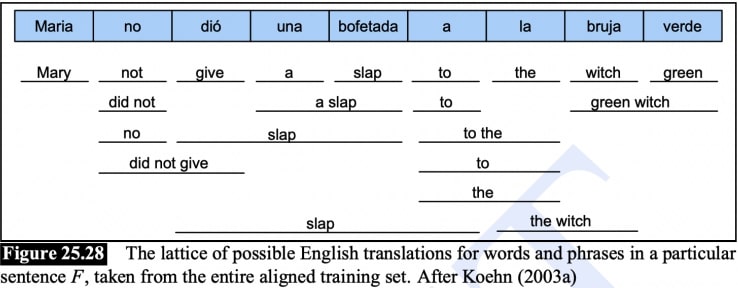Authored by Tony Feng
Created on Nov 1st, 2022
Last Modified on Nov 10th, 2022
Intro
This sereis of posts contains a summary of materials and readings from the course CSCI 1460 Computational Linguistics that I’ve taken @ Brown University. The class aims to explore techniques regarding recent advances in NLP with deep learning. I posted these “Notes” (what I’ve learnt) for study and review only.
Language Diversity and Challenges
- Perfect translation is not possible
- Morphology
- Isolating vs. polysynthetic
- Agglutinative vs. fusional languages
- Syntax
- Agument structure and marking
- Possession
- Motion, manner
- Referential Density
- Lexicon: Every language has both polysemy and redundancy
Noisy Channel Models for SMT
Noisy Channel Model
Consider a message sent across a noisy channel. To determine the message, you need to correct for the noise that was added.
$$ P(\operatorname{tgt} \mid \operatorname{src}) \propto P(\operatorname{src} \mid \operatorname{tgt}) P(\operatorname{tgt}) $$
,where $P(\operatorname{src} \mid \operatorname{tgt})$ is translation model and $P(\operatorname{tgt})$ is language model.
Translation Model
Word Alignment
Bitext / Bilingual Parallel Corpora is a corpus that contains translated pairs of texts.
- Document-level or Sentence level
- Word-level alignment is rare
IBM Model 1
IBM Model 1 is the 1st (simplest) automatic unsupervised alignment model from IBM.
- Choose length $L$ for source sentence
- Choose an alignment $A = a_1 … a_L$
- Generate target position $t_i$ by translating whatever source phrase is aligned to position $i$ in the target
- Find the alignment that makes each observed source word most likely given its aligned target word
Dilemma:
- We want alignments so that we can figure out the probabilities of phrase translations
- To estimate those alignments, we need phrase translation probabilities
EM Algorithm
Expectation Maximization Algorithm is an optimization algorithm for generative models. It works for
- If $P(a)$, then $P(b)$ can be computed.
- If $P(b)$, the $P(a)$ can be computed.
Basic idea:
- Randomly guess what $P(a)$ is
- Use it to compute $P(b)$
- Then, with your newly computed $P(b)$, recompute $P(a)$
- Iterate until convergence
Language Model
Greedy Search
Finding best translation (e.g., arg-maxing $P(s|t)P(t)$) is just a search problem!
- Greedy Search (Just for intuition)
- Beam Search (more common)
Beam Search
Finding the most optimal sequence is computationally hard, since the search space increases exponentially. Beam Search considers the top K at each time step.
- At first time step, choose k most likely words to be the initial “hypotheses”.
- Theb, the top $K$ best hypotheses are carried forward, (i.e., softmax over the whole vocab given each hypothesis, so $K*V$ computations)
- When </s> is generated, the generation is output.
- Continue until beam is empty
Problems:
- Heuristic and still not guaranteed to find best solution.
- Hard to deal with long range dependencies.
- Slow and memory intensive.
In practice, we often apply sampling $K$ continuations, rather than choosing the top $K$, which is controled by a temperature parameter.
- Higher temperature = more oversampling of lower probability continuations
- A low temperature (below 1) makes the model more confident.
- A high temperature (above 1) makes the model less confident.
- Intuition: “flatter” distribution

Full Phrase-Based MT System
 $$
\operatorname{cost}(E, F)=\prod_{i \in S} \phi\left(\overline{f_{i}}, \overline{e_{i}}\right) d\left(a_{i}-b_{i-1}\right) P(E)
$$
$$
\operatorname{cost}(E, F)=\prod_{i \in S} \phi\left(\overline{f_{i}}, \overline{e_{i}}\right) d\left(a_{i}-b_{i-1}\right) P(E)
$$
The cost is the product of all positions in the partial sentence, including translation probability, distortion probability, and language model probability.
Reference:
- Expectation Maximization Algorithm
- How to generate text: using different decoding methods for language generation with Transformers
- How does temperature affect softmax in machine learning?